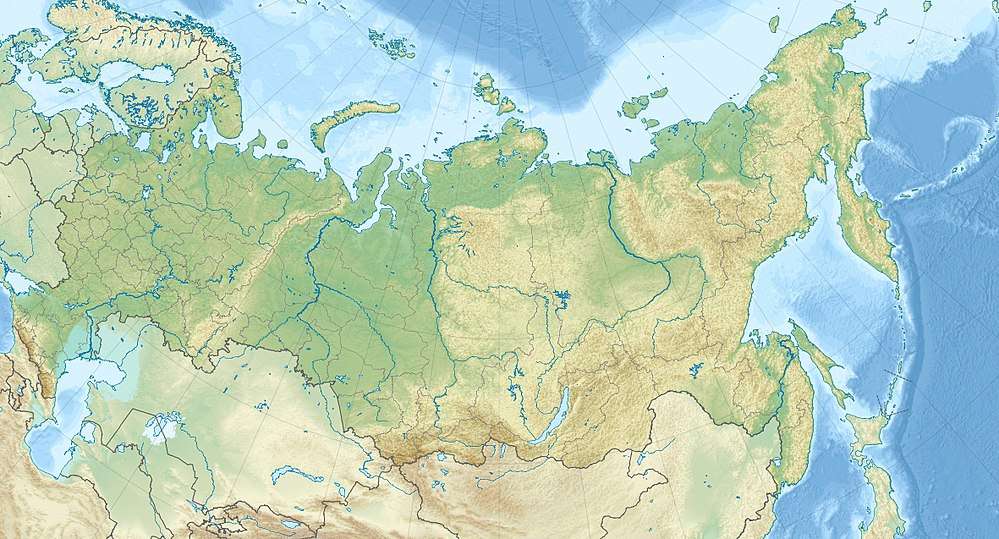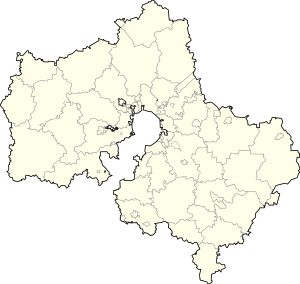Moskvoretskaya Formation
The Moskvoretskaya Formation is a Middle Jurassic (Bathonian stage) geologic formation in the European part of Russia. It consists of continental claystones, siltstones and sandstones deposited in karstified segments of underlying Middle Carboniferous limestone, that would have formed underground aquifers.
| Moskvoretskaya Formation Stratigraphic range: Bathonian ~168–167 Ma | |
|---|---|
| Type | Geological formation |
| Sub-units | Meshchera Member |
| Underlies | Callovian and Oxfordian marine claystones |
| Overlies | Unconformably (about 150 Ma) overlying and infilling Middle Carboniferous limestone |
| Area | Kolomensky District, Moscow Oblast |
| Thickness | Variable |
| Lithology | |
| Primary | Claystone, siltstone |
| Other | Sandstone |
| Location | |
| Coordinates | 55.2°N 38.8°E |
| Approximate paleocoordinates | 48.8°N 41.2°E |
| Region | Moscow |
| Country | |
| Extent | Localized in karstified limestones |
| Type section | |
| Named for | Moskva River |
 Moskvoretskaya Formation (Russia)  Moskvoretskaya Formation (Moscow Oblast) | |
The formation is divided up into two members, the lower consists of dark clays to silts and is highly fossiliferous, while the upper member is sandy and lean in fossil content.[1]
The remains of indeterminate tetanuran dinosaurs are known from the formation. As are fossil flora, fish and abundant remains of the turtle Heckerochelys romani,[2] and various other fossils.[3]
Fossil content
Turtles
| Turtles | ||||||
|---|---|---|---|---|---|---|
| Genus | Species | Location | Stratigraphic position | Material | Notes | |
| Heckerochelys | H. romani | Moscow | Kolomna | A stem turtle outside both extant groups[2] | ||
Therapsids
| Therapsids | ||||||
|---|---|---|---|---|---|---|
| Genus | Species | Location | Stratigraphic position | Material | Notes | |
| Morganucodontidae? | Gen. et sp. indet. | Femur | [4] | |||
Crocodyliforms
| Neosuchians | ||||||
|---|---|---|---|---|---|---|
| Genus | Species | Location | Stratigraphic position | Material | Notes | |
| Neosuchia | Gen. et sp. indet. | Moscow | Kolomna | Vertebrae, teeth, dentary fragment | [1] | |
Dinosaurs
| Dinosaurs | ||||||
|---|---|---|---|---|---|---|
| Genus | Species | Location | Stratigraphic position | Material | Notes | |
| Tetanurae | Gen. et sp. indet. | Includes a partial skull, tooths and postcraneal elements | Formerly referred to Richardoestesia and Coelurosauria[1][5] | |||
Fish
- Ceratodus segnis
- Ischyodus cf. egertoni[1]
- Hybodus sp.[1]
- Lepidotes sp.
- Ptycholepis sp.
- Dapediidae indet.
Flora
Other
- Scyadopitys verticillata
- cf. Gobiops sp.
- ?Cteniogenys sp.[1]
- Caudata indet.
gollark: Radioisotope thermoelectric generator.
gollark: But really, any decently powerful modern computer could *easily* control a bunch of drones.
gollark: Phones have power constraints too, since they use uncool batteries instead of superior RTGs.
gollark: It's *amazing* how hilariously underutilized computers are half the time. It doesn't help that most software is ridiculously wasteful.
gollark: You can exchange goods and services for money, then exchange money for goods and services.
See also
- List of dinosaur-bearing rock formations
- List of fossiliferous stratigraphic units in Russia
- Mitchell Plain, karst field in Mississippian limestone in Indiana, United States
- Bemaraha Formation, Bathonian dinosaur-bearing formation of Madagascar
- Itat Formation, Middle Jurassic fossiliferous formation of Western Siberia
References
- Pashschenko et al., 2018
- Sukhanov, 2006
- Moskvoretskaya Formation at Fossilworks.org
- Lopatin & Averianov, 2006
- Alifanov & Sennikov, 2001
Bibliography
- Pashchenko, D.I.; I.T. Kuzmin; A.G. Sennikov; P.P. Skutschas, and M.B. Efimov. 2018. On the Finding of Neosuchians (Neosuchia, Crocodyliformes) in the Middle Jurassic (Bathonian) Deposits of the Moscow Region. Paleontological Journal 52. 550–562. Accessed 2019-10-12. doi:10.1134/S0031030118050118 ISSN 0031-0301
- Lopatin, A.V., and A.O. Averianov. 2006. Mesozoic mammals of Russia. 9th International Symposium on Mesozoic Terrestrial Ecosystems and Biota, Abstracts and Proceedings Volume 67-70.
- Sukhanov, V.B. 2006. An archaic turtle, Heckerochelys romani gen. et sp. nov. from the Middle Jurassic of Moscow region, Russia. Fossil Turtle Research 1. 112-118. Accessed 2019-10-12.
- Alifanov, V.R., and A.G. Sennikov. 2001. Discovery of dinosaur remains in a Moscow suburb. Doklady Earth Sciences 376. 1-3. Accessed 2019-10-12.
Further reading
- Weishampel, David B.; Peter Dodson, and Halszka Osmólska (eds.). 2004. The Dinosauria, 2nd edition, 1–880. Berkeley: University of California Press. Accessed 2019-02-21.ISBN 0-520-24209-2
This article is issued from Wikipedia. The text is licensed under Creative Commons - Attribution - Sharealike. Additional terms may apply for the media files.